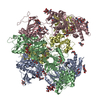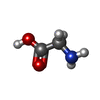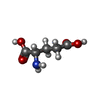[English] 日本語
 Yorodumi
Yorodumi- PDB-7yfh: Structure of the Rat GluN1-GluN2C NMDA receptor in complex with g... -
+ Open data
Open data
- Basic information
Basic information
| Entry | Database: PDB / ID: 7yfh | ||||||
|---|---|---|---|---|---|---|---|
| Title | Structure of the Rat GluN1-GluN2C NMDA receptor in complex with glycine, glutamate and (R)-PYD-106 | ||||||
 Components Components | (Glutamate receptor ionotropic, NMDA ...) x 2 | ||||||
 Keywords Keywords | MEMBRANE PROTEIN / NMDA receptor / GluN2C | ||||||
| Function / homology |  Function and homology information Function and homology informationdirectional locomotion / pons maturation / positive regulation of Schwann cell migration / regulation of cell communication / EPHB-mediated forward signaling / Assembly and cell surface presentation of NMDA receptors / olfactory learning / conditioned taste aversion / dendritic branch / regulation of respiratory gaseous exchange ...directional locomotion / pons maturation / positive regulation of Schwann cell migration / regulation of cell communication / EPHB-mediated forward signaling / Assembly and cell surface presentation of NMDA receptors / olfactory learning / conditioned taste aversion / dendritic branch / regulation of respiratory gaseous exchange / protein localization to postsynaptic membrane / transmitter-gated monoatomic ion channel activity / suckling behavior / response to glycine / propylene metabolic process / regulation of monoatomic cation transmembrane transport / RAF/MAP kinase cascade / NMDA glutamate receptor activity / Synaptic adhesion-like molecules / voltage-gated monoatomic cation channel activity / response to glycoside / NMDA selective glutamate receptor complex / glutamate binding / ligand-gated sodium channel activity / neurotransmitter receptor complex / response to morphine / regulation of axonogenesis / neuromuscular process controlling balance / calcium ion transmembrane import into cytosol / neuromuscular process / regulation of dendrite morphogenesis / protein heterotetramerization / male mating behavior / regulation of synapse assembly / glycine binding / response to amine / parallel fiber to Purkinje cell synapse / startle response / monoatomic cation transmembrane transport / positive regulation of reactive oxygen species biosynthetic process / positive regulation of calcium ion transport into cytosol / cellular response to glycine / associative learning / excitatory synapse / positive regulation of dendritic spine maintenance / monoatomic cation transport / social behavior / regulation of neuronal synaptic plasticity / glutamate receptor binding / monoatomic ion channel complex / Unblocking of NMDA receptors, glutamate binding and activation / positive regulation of excitatory postsynaptic potential / long-term memory / synaptic cleft / prepulse inhibition / phosphatase binding / positive regulation of synaptic transmission, glutamatergic / monoatomic cation channel activity / calcium ion homeostasis / response to fungicide / glutamate-gated receptor activity / regulation of neuron apoptotic process / cellular response to manganese ion / glutamate-gated calcium ion channel activity / presynaptic active zone membrane / dendrite membrane / sensory perception of pain / ligand-gated monoatomic ion channel activity involved in regulation of presynaptic membrane potential / ionotropic glutamate receptor signaling pathway / sodium ion transmembrane transport / synaptic membrane / response to amphetamine / hippocampal mossy fiber to CA3 synapse / adult locomotory behavior / learning / regulation of membrane potential / excitatory postsynaptic potential / transmitter-gated monoatomic ion channel activity involved in regulation of postsynaptic membrane potential / synaptic transmission, glutamatergic / PDZ domain binding / regulation of long-term neuronal synaptic plasticity / postsynaptic density membrane / response to calcium ion / neuron cellular homeostasis / cerebral cortex development / negative regulation of protein catabolic process / regulation of synaptic plasticity / visual learning / calcium ion transmembrane transport / response to wounding / calcium channel activity / memory / long-term synaptic potentiation / intracellular calcium ion homeostasis / terminal bouton / synaptic vesicle / synaptic vesicle membrane / calcium ion transport / rhythmic process / signaling receptor activity Similarity search - Function | ||||||
| Biological species |  | ||||||
| Method | ELECTRON MICROSCOPY / single particle reconstruction / cryo EM / Resolution: 3 Å | ||||||
 Authors Authors | Zhang, M. / Zhang, J. / Guo, F. / Li, Y. / Zhu, S. | ||||||
| Funding support |  China, 1items China, 1items
| ||||||
 Citation Citation |  Journal: Nat Struct Mol Biol / Year: 2023 Journal: Nat Struct Mol Biol / Year: 2023Title: Distinct structure and gating mechanism in diverse NMDA receptors with GluN2C and GluN2D subunits. Authors: Jilin Zhang / Ming Zhang / Qinrui Wang / Han Wen / Zheyi Liu / Fangjun Wang / Yuhang Wang / Fenyong Yao / Nan Song / Zengwei Kou / Yang Li / Fei Guo / Shujia Zhu /  Abstract: N-methyl-D-aspartate (NMDA) receptors are heterotetramers comprising two GluN1 and two alternate GluN2 (N2A-N2D) subunits. Here we report full-length cryo-EM structures of the human N1-N2D di- ...N-methyl-D-aspartate (NMDA) receptors are heterotetramers comprising two GluN1 and two alternate GluN2 (N2A-N2D) subunits. Here we report full-length cryo-EM structures of the human N1-N2D di-heterotetramer (di-receptor), rat N1-N2C di-receptor and N1-N2A-N2C tri-heterotetramer (tri-receptor) at a best resolution of 3.0 Å. The bilobate N-terminal domain (NTD) in N2D intrinsically adopts a closed conformation, leading to a compact NTD tetramer in the N1-N2D receptor. Additionally, crosslinking the ligand-binding domain (LBD) of two N1 protomers significantly elevated the channel open probability (Po) in N1-N2D di-receptors. Surprisingly, the N1-N2C di-receptor adopted both symmetric (minor) and asymmetric (major) conformations, the latter further locked by an allosteric potentiator, PYD-106, binding to a pocket between the NTD and LBD in only one N2C protomer. Finally, the N2A and N2C subunits in the N1-N2A-N2C tri-receptor display a conformation close to one protomer in the N1-N2A and N1-N2C di-receptors, respectively. These findings provide a comprehensive structural understanding of diverse function in major NMDA receptor subtypes. #1:  Journal: Nat.Struct.Mol.Biol. / Year: 2023 Journal: Nat.Struct.Mol.Biol. / Year: 2023Title: Distinct structure and gating mechanism in diverse NMDA receptors with GluN2C and GluN2D subunits Authors: Zhang, M. / Zhu, S. | ||||||
| History |
|
- Structure visualization
Structure visualization
| Structure viewer | Molecule:  Molmil Molmil Jmol/JSmol Jmol/JSmol |
|---|
- Downloads & links
Downloads & links
- Download
Download
| PDBx/mmCIF format |  7yfh.cif.gz 7yfh.cif.gz | 541.7 KB | Display |  PDBx/mmCIF format PDBx/mmCIF format |
|---|---|---|---|---|
| PDB format |  pdb7yfh.ent.gz pdb7yfh.ent.gz | 438.9 KB | Display |  PDB format PDB format |
| PDBx/mmJSON format |  7yfh.json.gz 7yfh.json.gz | Tree view |  PDBx/mmJSON format PDBx/mmJSON format | |
| Others |  Other downloads Other downloads |
-Validation report
| Summary document |  7yfh_validation.pdf.gz 7yfh_validation.pdf.gz | 2.1 MB | Display |  wwPDB validaton report wwPDB validaton report |
|---|---|---|---|---|
| Full document |  7yfh_full_validation.pdf.gz 7yfh_full_validation.pdf.gz | 2.1 MB | Display | |
| Data in XML |  7yfh_validation.xml.gz 7yfh_validation.xml.gz | 85.3 KB | Display | |
| Data in CIF |  7yfh_validation.cif.gz 7yfh_validation.cif.gz | 127.2 KB | Display | |
| Arichive directory |  https://data.pdbj.org/pub/pdb/validation_reports/yf/7yfh https://data.pdbj.org/pub/pdb/validation_reports/yf/7yfh ftp://data.pdbj.org/pub/pdb/validation_reports/yf/7yfh ftp://data.pdbj.org/pub/pdb/validation_reports/yf/7yfh | HTTPS FTP |
-Related structure data
| Related structure data |  33790MC  7yffC  7yfgC  7yfiC  7yflC  7yfmC  7yfoC  7yfrC  8hdkC M: map data used to model this data C: citing same article ( |
|---|---|
| Similar structure data | Similarity search - Function & homology  F&H Search F&H Search |
- Links
Links
- Assembly
Assembly
| Deposited unit | 
|
|---|---|
| 1 |
|
- Components
Components
-Glutamate receptor ionotropic, NMDA ... , 2 types, 4 molecules ACBD
| #1: Protein | Mass: 97574.625 Da / Num. of mol.: 2 Source method: isolated from a genetically manipulated source Source: (gene. exp.)   Homo sapiens (human) / References: UniProt: P35439 Homo sapiens (human) / References: UniProt: P35439#2: Protein | Mass: 87753.758 Da / Num. of mol.: 2 Source method: isolated from a genetically manipulated source Source: (gene. exp.)   Homo sapiens (human) / References: UniProt: Q00961 Homo sapiens (human) / References: UniProt: Q00961 |
|---|
-Sugars , 3 types, 30 molecules 
| #3: Polysaccharide | alpha-D-mannopyranose-(1-4)-2-acetamido-2-deoxy-beta-D-glucopyranose-(1-4)-2-acetamido-2-deoxy-beta- ...alpha-D-mannopyranose-(1-4)-2-acetamido-2-deoxy-beta-D-glucopyranose-(1-4)-2-acetamido-2-deoxy-beta-D-glucopyranose Source method: isolated from a genetically manipulated source #4: Polysaccharide | 2-acetamido-2-deoxy-beta-D-glucopyranose-(1-4)-2-acetamido-2-deoxy-beta-D-glucopyranose Source method: isolated from a genetically manipulated source #5: Sugar | ChemComp-NAG / |
|---|
-Non-polymers , 3 types, 5 molecules 




| #6: Chemical | | #7: Chemical | #8: Chemical | ChemComp-IWB / | |
|---|
-Details
| Has ligand of interest | Y |
|---|---|
| Has protein modification | Y |
-Experimental details
-Experiment
| Experiment | Method: ELECTRON MICROSCOPY |
|---|---|
| EM experiment | Aggregation state: PARTICLE / 3D reconstruction method: single particle reconstruction |
- Sample preparation
Sample preparation
| Component | Name: Rat GluN1-GluN2C NMDA receptor in complex with glycine, glutamate and (R)-PYD-106 Type: ORGANELLE OR CELLULAR COMPONENT / Entity ID: #1-#2 / Source: RECOMBINANT |
|---|---|
| Molecular weight | Experimental value: NO |
| Source (natural) | Organism:  |
| Source (recombinant) | Organism:  Homo sapiens (human) Homo sapiens (human) |
| Buffer solution | pH: 8 |
| Specimen | Conc.: 4.2 mg/ml / Embedding applied: NO / Shadowing applied: NO / Staining applied: NO / Vitrification applied: YES |
| Specimen support | Grid material: GOLD / Grid mesh size: 300 divisions/in. / Grid type: Quantifoil R1.2/1.3 |
| Vitrification | Instrument: FEI VITROBOT MARK IV / Cryogen name: ETHANE / Humidity: 100 % / Chamber temperature: 281 K |
- Electron microscopy imaging
Electron microscopy imaging
| Experimental equipment |  Model: Titan Krios / Image courtesy: FEI Company |
|---|---|
| Microscopy | Model: FEI TITAN KRIOS |
| Electron gun | Electron source:  FIELD EMISSION GUN / Accelerating voltage: 300 kV / Illumination mode: FLOOD BEAM FIELD EMISSION GUN / Accelerating voltage: 300 kV / Illumination mode: FLOOD BEAM |
| Electron lens | Mode: BRIGHT FIELD / Nominal defocus max: 2000 nm / Nominal defocus min: 1200 nm |
| Image recording | Electron dose: 60 e/Å2 / Film or detector model: DIRECT ELECTRON DE-10 (5k x 4k) |
| Image scans | Width: 5760 / Height: 9042 |
- Processing
Processing
| EM software |
| ||||||||||||||||||||||||||||
|---|---|---|---|---|---|---|---|---|---|---|---|---|---|---|---|---|---|---|---|---|---|---|---|---|---|---|---|---|---|
| CTF correction | Type: PHASE FLIPPING AND AMPLITUDE CORRECTION | ||||||||||||||||||||||||||||
| Particle selection | Num. of particles selected: 2094482 | ||||||||||||||||||||||||||||
| Symmetry | Point symmetry: C1 (asymmetric) | ||||||||||||||||||||||||||||
| 3D reconstruction | Resolution: 3 Å / Resolution method: FSC 0.143 CUT-OFF / Num. of particles: 601826 / Symmetry type: POINT |
 Movie
Movie Controller
Controller










 PDBj
PDBj









